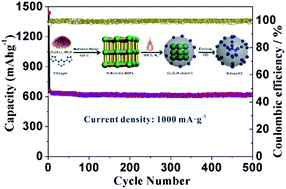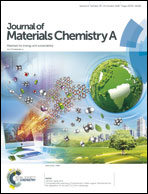MOF-derived honeycomb-like N-doped carbon structures assembled from mesoporous nanosheets with superior performance in lithium-ion batteries†
Abstract
Nitrogen-doped carbon honeycomb-like (NCH) structures assembled from two-dimensional (2D) mesoporous nanosheets have been prepared using a N-rich MOF as a template via thermal annealing under a N2 atmosphere, followed by an acid etching treatment. The as-obtained NCH nanofilms show favorable features including high N-doping (19%) and rich defects, a mesoporous structure (3.7 nm) and a honeycomb-like morphology for electrochemical energy storage. Due to the multiple synergistic effects of the above features, the sample, as an anode material for lithium-ion batteries (LIBs), exhibits excellent electrochemical properties. The specific capacity can remain at a stable value of about 609 mA h g−1 at a current of 1 A g−1 for 500 cycles. The theoretical calculated results indicate that the high content of pyridinic N in the sample may result in high performance of LIBs. We further designed two different strategies to recycle and reuse cobalt sources in the remaining solution, which effectively reduced costs and avoided unnecessary waste.



 Please wait while we load your content...
Please wait while we load your content...